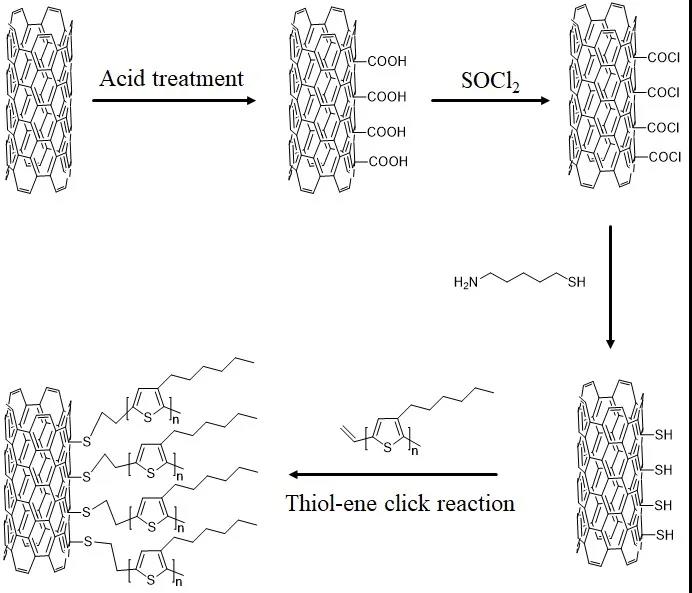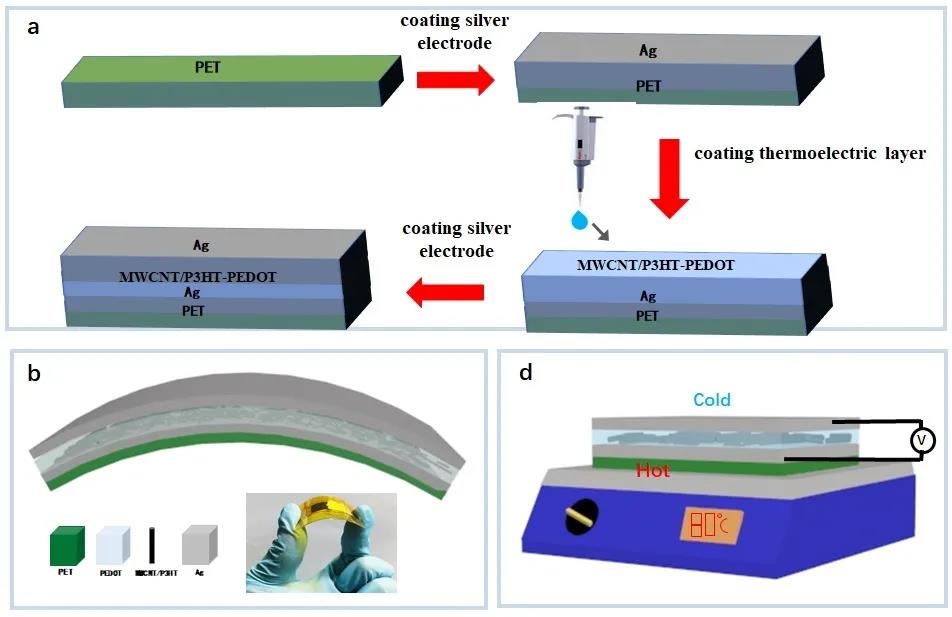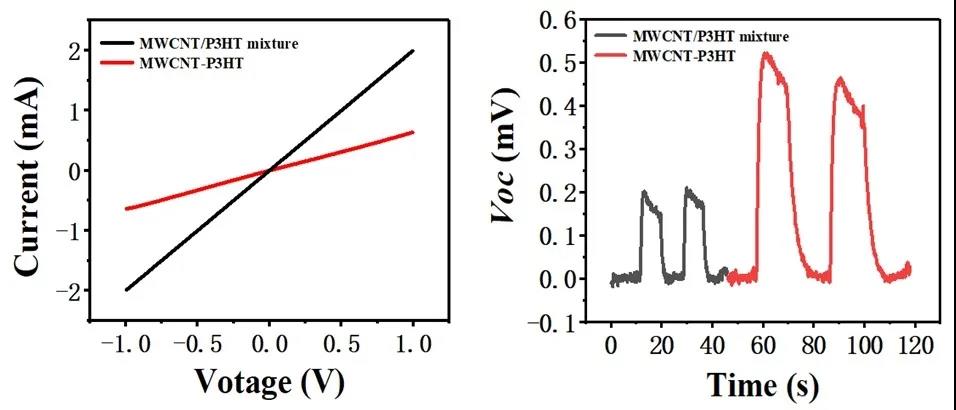
hotline:
17715390137
Tel/Wechat:
18101240246 (Technology)
0512-68565571
Email:mxenes@163.com (Sales Engineer)bkxc.bonnie@gmail.com
Scan the code to follow or search the official account on WeChat:
2D Materials Fronrier After paying attention,
click on the lower right corner to contact us,
Enter enterprise WeChat.
Professional Services Online

Covalent connection between carbon nanotubes and P3HT through thiol-ene click chemistry to improve thermoelectric performance
In recent years, composite materials of carbon nanotubes (CNTs) and conjugated polymers have gradually attracted attention. Among them, poly (3-hexylthiophene) (P3HT) has become the most widely used conjugated polymer material due to its high electrical conductivity and easy chemical modification. CNT / P3HT nanocomposites combine high-conductivity CNTs with low thermal conductivity P3HT to prepare low-density, high-performance thermoelectric materials. Generally, CNT / P3HT nanocomposites can be connected by non-covalent or covalent interactions between the two. Among them, covalent connection can establish a close relationship between the two. However, in the process of preparing CNT-P3HT nanocomposites by covalently linking CNT and P3HT, the methods reported in the literature have problems such as low conversion rate and harsh reaction conditions.
Recently, Xu Hui‘s group of Nanjing University of Technology and Xie Yannan‘s group of Nanjing University of Posts and Telecommunications collaborated to synthesize a covalently-linked CNT-P3HT composite material through a simple and effective click reaction between mercapto-enes (Figure 1). The morphology and structure, optical properties and thermoelectric properties of the composites were compared and analyzed.

Figure 1. Schematic of the synthesis of CNT-P3HT nanocomposites
The results show that compared with physically mixed MWCNT / P3HT, the π-π accumulation of P3HT in MWCNT-P3HT composites synthesized by the click reaction is reduced; in addition, a tight and permanent covalent connection is formed between P3HT and MWCNT. Promote electron transfer from P3HT to MWCNT (Figure 2).

Figure 2. UV-visible absorption spectrum and photoluminescence spectrum of CNT-P3HT material
By click reaction, MWCNT-P3HT composite with high grafting rate can be synthesized under simple and mild reaction conditions and short reaction time, and the components of P3HT can be precisely controlled. Electron microscopy (Figure 3) shows that P3HT is evenly distributed on the surface of MWCNTs. Effective covalent grafting improves the dispersibility of MWCNTs in organic solvents. While reducing the difficulty of device preparation, it also improves the flexibility of composite materials and the potential of composite materials for flexible devices.

Figure 3. SEM and TEM comparison of original carbon tube and MWCNT-P3HT composite
MWCNT-P3HT materials synthesized by physical blending and click reaction were used to make flexible thermoelectric devices (Figure 4). The IV characteristics and output voltage characteristics of flexible thermoelectric devices show that the CNT-P3HT material synthesized by the click reaction has a better Seebeck coefficient and power factor than the physically blended thermoelectric material, which may be due to the covalence between P3HT and MWCNT The connection enhances phonon scattering, which improves the thermoelectric output performance of the device (Figure 5).

Figure 4. Device structure of flexible thermoelectric material

Figure 5. I-V and output voltage characteristics of flexible thermoelectric materials
This work synthesizes tightly connected MWCNT-P3HT composites through mild and efficient click reactions. While effectively improving the dispersibility of carbon nanotubes, it also enhances the interface transfer of electrons from P3HT to MWCNT, resulting in less P3HT content. Composite materials can still show excellent Seebeck coefficient and power factor. This method is simple and versatile, and provides new ideas for the subsequent synthesis of various conjugated polymer / MWCNT composite materials and the preparation of optoelectronic, thermoelectric and other devices.

| Reminder: Beijing Beike New Material Technology Co., Ltd. supplies products only for scientific research, not for humans |
| All rights reserved © 2019 beijing beike new material Technology Co., Ltd 京ICP备16054715-2号 |